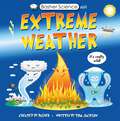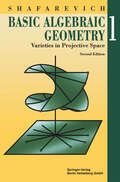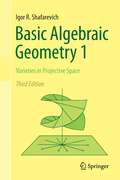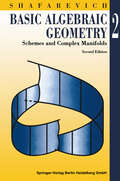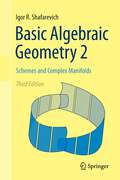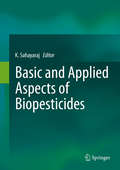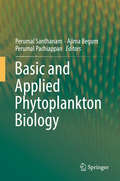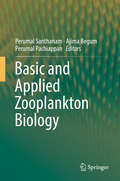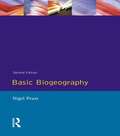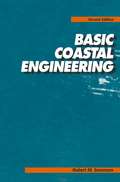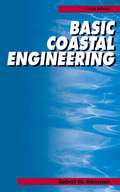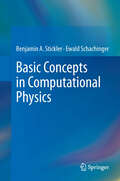- Table View
- List View
Basement Correlation Across the North Atlantic
by Jean-Pierre LefortMajor structural features are used in this study to reconstruct the links which existed between North America, Europe and Africa before the opening of the North Atlantic Ocean. The synthesis of geophysical and geochemical data as well as geological observations allows the recognition of the original geometry of the Grenvillian, Cadomian, Caledonian, Ligerian-Acadian and Hercynian foldbelts and the identification of ancient plate sutures. The reader will find a wealth of information based not only on the English but also on the French and Spanish literature, thus opening less known results to the international community.
Basement Tectonics 10 (Proceedings of the International Conferences on Basement Tectonics #4)
by John C. Green Albert B. Dickas Richard W. OjakangasThe 10th International Basement Tectonics Conference was conducted on the campus of the University of Minnesota, Duluth, in Duluth, Minnesota, USA, from August I through August 11, 1992. A total of 78 individuals were in attendance, 47 of which represented the host country, with the remaining 31 traveling from 11 different foreign countries. The four days of presentations were divided into three technical sessions, namely "Shear Zones", "Basement Control On Younger Structures", and "Rifting Midcontinent Rift System". This tripartite conference theme was also employed in the field trip agenda with three excursions being offered, all ably organized by Field Trip Chairman John C. Green. The pre-conference trip set the stage through a two day review of the "Archean and Early Proterozoic Rocks of Northeastern Minnesota". Under beautiful summer skies, 16 sites were visited within the Vermilion district of Minnesota, considered to be the best example of an Archean greenstone belt in the United States. All registrants participated in the mid-conference trip conducted along the gabbroic and volcanic terrain of the "Midcontinent Rift, Northeastern Minnesota".
Basement Tectonics 11 Europe and Other Regions: Proceedings of the Eleventh International Conference on Basement Tectonics, held in Potsdam, Germany, July 1994 (Proceedings of the International Conferences on Basement Tectonics #5)
by O. Oncken C. JanssenThe Eleventh International Conference on Basement Tectonics was held at the GeoForschungsZentrum Potsdam in Germany 25-29 July 1994. It was the first time that a meeting of this series took place in the centre of Europe and the first such meeting in this area after the recent political changes in eastern Europe. Consequently, the main theme of the meeting focussed on the structure and history of the entire European continent. Further themes were grouped around topics of current interest. Keynote lectures on these topics were given by A. Berthelsen, St. Mueller, A. Green, and D. Fountain. The technical sessions were arranged with support of the Scientific Committee on the following topics: 1. Continental scale features of basement rocks of phanerozoic cratons - with emphasis on Europe 2. Extrapolation and correlation of geological and geophysical data from basement rocks: an assessment 3. Mechanisms of basement exhumation in the evolution of orogenic belts 4. Structure and intraplate deformation of the North-American craton Papers submitted to this volume have however all been collected in one part since all of them deal with different aspects of deformation of the continental basement. A second part contains a complete list of all papers and posters presented at the meeting. Field trips to study some of the above mentioned aspects in the Harz mountains, the Granulite Massif, and the Erzgebirge were organized by P. Bankwitz, P. Frischbutter, 1. Rotzler, K. Rotzler, and B. Mingram. Their assistance is gratefully acknowledged.
Basement Tectonics 12: Central North America and Other Regions (Proceedings of the International Conferences on Basement Tectonics #6)
by John P. Hogan M. Charles GilbertProceedings of the Twelfth International Conference on Basement Tectonics held in Norman, Oklahoma, U.S.A., May 1995
Basement Tectonics 13: Proceedings of the Thirteenth International Confenrence on Basement Tectonics, held in Blacksburg, Virginia, U.S.A., June 1997 (Proceedings of the International Conferences on Basement Tectonics #7)
by A. Krishna SinhaThe Thirteenth International Conference on Basement Tectonics was held on the campus of Virginia Polytechnic Institute and State University in Blacksburg, Virginia from June 2 -6, 1997. The oral presentations and discussions over three days covered a wide range of topics, and provided the international audience with a perspective on scientific efforts underway around the world. The conference participants were able to attend two separate field trips: (I) a pre-conference trip guided by Professor Robert Hatcher of the University of Tennessee, Knoxville, examined the Basement rocks in the North Carolina -Tennessee region of the Appalachian Mountains, and (2) a mid-conference field trip guided by A.K. Sinha, convener of the conference, allowed participants to examine the complex rock associations and structures of the> 1000 m.y. old basement rocks in Virginia. Both the field trip guidebooks and abstract volumes were published for the conference. The meeting brought together scientists from more than 14 countries. Their participation, and the fiscal success of the meeting would not have been possible without the support of the Department of Geological Sciences, the College of Arts and Sciences (VPI&SU) and the Basement Tectonics Association. Their support is gratefully acknowledged. As Chairman of the Organizing Committee, I would like to thank Margie Sentelle, Jay Thomas, Peter Welch, and Barry Robinson for the smooth operation of the conference.
Basement Tectonics 7: Proceedings of the Seventh International Conference on Basement Tectonics, held in Kingston, Ontario, Canada, August 1987 (Proceedings of the International Conferences on Basement Tectonics #1)
by John M. SiliskiProceedings of the Seventh International Conference on Basement Tectonics, held in Kingston, Ontario, Canada, August 1987
Basement Tectonics 8: Characterization and Comparison of Ancient and Mesozoic Continental Margins (Proceedings of the International Conferences on Basement Tectonics #2)
by Mervin J. Bartholomew Donald W. Hyndman David W. Mogk Robert MasonThe 8th International Conference on Basement Tectonics was held in Butte, Montana, August 8-12,1988. Historically, basement tectonics conferences have focused on such topics as reactivation of faults, the influence of basement faults on metallogeny and hyrocarbon accumulation, and the use of geophysical and remote sensing techniques to interpret subsurface and surface geology. The 8th Conference diverged from past conferences in that a unifying theme was selected. Because ancient major terrane or cratonic boundaries are often postulated to be fault zones which are subsequently reactivated, the conference was organized to examine all aspects of ancient continental margins and terrane boundaries and to compare younger (Mesozoic) ones, about which more is known, with older (Paleozoic and Precambrian) ones. Moreover, because the 8th Conference was held in the northwestern United States, a greater emphasis was placed on the Mesozoic margin of western North America and the North American shield. The seven oral sessions and four poster sessions all dealt with aspects of the conference theme: characterization and comparison of ancient continental margins. The organizers extend their thanks to those individuals who graciously consented to serve as moderators for the oral sessions: John M. Bartley, Mark S. Gettings, M. Charles Gilbert, John M. Guilbert, Donald W. Hyndman, William P. Leeman, Robert Mason, and A. Krishna Sinha. The program with abstracts volume was prepared by S. E. Lewis and M. J. Bartholomew.
Basement Tectonics 9: Australia and Other Regions Proceedings of the Ninth International Conference on Basement Tectonics, held in Canberra, Australia, July 1990 (Proceedings of the International Conferences on Basement Tectonics #3)
by M. J. Rickard H. J. Harrington P. R. WilliamsThe Ninth International Conference on Basement Tectonics was held at the Australian National University in Canberra 2-6 July 1990. The opening keynote address was given by Prof. R.W.R. Rutland, Director of the Bureau of Mineral Resources. Other keynote speakers were E.S.T. O'Driscoll, an Australian consultant, and Prof P. Bankwitz, Central Institute for Physics of the Earth, Potsdam, GDR. Technical sessions were arranged by session conveners on the following five topic- i) The structure of the Australian craton and cover basins; ii) Basement structure of continental regions; iii) Structural patterns and mineral deposits; iv) Techniques for analysing basement structures; v) Structural patterns in oceanic crust. The arrangement of papers for this Proceedings Volume has been simplified. Part 1 deals with Australia, Part 2 with other areas and Part 3 lists the titles of all the papers read at the conference. Abstracts of these papers are available in Geological Society of Australia Abstracts No 26 and may be purchased for $AI0 from the Geological Society of Australia Office, ANA House, 301 George Street, Sydney NSW 2000. Field trips to view aspects of the Lachlan Fold Belt and the Sydney Basin were assisted by H.J. Harrington, D. Branagan, D. Wyborn, B. Drummond and M.J. Rick~d. A longer field trip, aborted through low enrolments, was organized by H.J. Harrington with assistance from W. Preiss, N. Cook, R. Glenn, A. Grady, and P. James; this assistance is gratefully acknowledged.
Basher Science Mini: It's really wild!
by Tom JacksonThings are hotting up, but not in a good way! Every year, millions of people across the globe find themselves at the mercy of Heat Wave, Drought or Flood – they’re friends of Climate Change, who is wreaking havoc on our planet.Step inside to learn more about these extreme characters. But first, let Weather System, Seasons and Climate tell you how weather works. Find out just what it is about Climate Change that is making things more intense. And whatever you do, don’t panic! Just as there are troublemakers in this turbulent world, there are heroes who want to calm things down: Flood Defences and Firefighting will bring you up to speed.Basher Science Mini: Extreme Weather gives kids the lowdown on one of the most pressing problems that we face: extreme weather. Basher's unique illustrations combine with chatty, first-person text by expert author Tom Jackson to hook even the most reluctant readers and help them to understand the science behind the headlines.Perfect for home or school, Basher's highly original books make difficult concepts tangible, understandable and even lovable. With sales of over 3 million copies around the world, they are a brilliant way to communicate science, history and geography.
Basher Science Mini: Green Technology (Basher #138)
by Tom JacksonWorld, we’ve got a problem! Climate Change. Make that two problems as Pollution is in the frame. In Basher Science Mini: Green Technology, scientific wizardry rides to the planet’s rescue. From saving the birds and the bees, to cleaning up the seas and waving goodbye to plastics, green tech is part of the solution to climate change. Some solutions are really out there, take a bow Space Mirrors, while others are close to home, we see you, Solar Panels! And you, too, Electric Vehicle! Our motto is protect and repair. Let’s get started.Perfect for home or school, Basher's highly original books make difficult concepts tangible, understandable and even lovable. Chatty first-person text and stylish, contemporary character illustrations give a voice, personality and story to each topic – a brilliant way to communicate science.
Basic Algebraic Geometry 1
by Igor R. ShafarevichThis book is a revised and expanded new edition of the first four chapters of Shafarevich’s well-known introductory book on algebraic geometry. Besides correcting misprints and inaccuracies, the author has added plenty of new material, mostly concrete geometrical material such as Grassmannian varieties, plane cubic curves, the cubic surface, degenerations of quadrics and elliptic curves, the Bertini theorems, and normal surface singularities.
Basic Algebraic Geometry 1: Varieties in Projective Space
by Igor R. ShafarevichShafarevich's Basic Algebraic Geometry has been a classic and universally used introduction to the subject since its first appearance over 40 years ago. As the translator writes in a prefatory note, ``For all [advanced undergraduate and beginning graduate] students, and for the many specialists in other branches of math who need a liberal education in algebraic geometry, Shafarevich’s book is a must.'' The third edition, in addition to some minor corrections, now offers a new treatment of the Riemann--Roch theorem for curves, including a proof from first principles.Shafarevich's book is an attractive and accessible introduction to algebraic geometry, suitable for beginning students and nonspecialists, and the new edition is set to remain a popular introduction to the field.
Basic Algebraic Geometry 2: Schemes and Complex Manifolds
by Igor R. ShafarevichThe second volume of Shafarevich's introductory book on algebraic geometry focuses on schemes, complex algebraic varieties and complex manifolds. As with first volume the author has revised the text and added new material. Although the material is more advanced than in Volume 1 the algebraic apparatus is kept to a minimum making the book accessible to non-specialists. It can be read independently of the first volume and is suitable for beginning graduate students.
Basic Algebraic Geometry 2: Schemes and Complex Manifolds
by Igor R. ShafarevichShafarevich's Basic Algebraic Geometry has been a classic and universally used introduction to the subject since its first appearance over 40 years ago. As the translator writes in a prefatory note, ``For all [advanced undergraduate and beginning graduate] students, and for the many specialists in other branches of math who need a liberal education in algebraic geometry, Shafarevich’s book is a must.''The second volume is in two parts: Book II is a gentle cultural introduction to scheme theory, with the first aim of putting abstract algebraic varieties on a firm foundation; a second aim is to introduce Hilbert schemes and moduli spaces, that serve as parameter spaces for other geometric constructions. Book III discusses complex manifolds and their relation with algebraic varieties, Kähler geometry and Hodge theory. The final section raises an important problem in uniformising higher dimensional varieties that has been widely studied as the ``Shafarevich conjecture''.The style of Basic Algebraic Geometry 2 and its minimal prerequisites make it to a large extent independent of Basic Algebraic Geometry 1, and accessible to beginning graduate students in mathematics and in theoretical physics.
Basic and Applied Aspects of Biopesticides
by K. SahayarajCurrently, the major challenge of humanity is focused on population growth through agricultural production in order to meet the demand for food. The food crunch is mainly due to pest and disease. Traditional methods, synthetic insecticides and microbicides cause health hazards to human beings, domestic animals and also affect our immediate environments. Serious concerns were implemented by both developing and developed countries as Integrated Pest Management (IPM) and Bio-intensive Integrated Pest Management (BIPM) systems where biopesticides play an important role worldwide. The available books are limited to particular aspects of biopesticides. Hence, it is imperative to bring out a holistic documentation which will provide the reader information on all aspects of biopesticides. The book consists of five sections namely microbials, botanicals, natural enemies semio- chemicals and biotechnology and equipments, bioinformatics tools and IPM. In Section I, microbial deals with utilization of Bacillus in control of phytonematodes; biological control of pest and diseases with fluorescent pseudomonads, entomopathogenic fungus and entomopathogenic nematodes in pest management, microbial viral insecticides and microbial elicitors to induce immunity for plant disease control in chilli and tomato. Importance of plant essential oils, botanicals in endocrine disruption, relevance of botanicals and use of plant volatile on pest management has been discussed in Section II. Importance and role of reduviidae, weaver ants, ground beetles, Odonatas, spiders in biological control has been discussed in Section III. In addition, genetic improvement of biocontrol agents for sustainable pest management has also been highlighted. In Section IV, classical practices and pheromone, kairomonal enhancement to natural enemies and use of transgenic plants in insect control are highlighted. Equipment and their application methodologies for application of biopesticides; relevance of bioinformatics in biopesticides management; pest management of soybean, bio fouling and eco friendly antifoulants have been highlighted in Section V. Each chapter has objectives and conclusion along with recommendations.
Basic and Applied Phytoplankton Biology
by Perumal Santhanam Ajima Begum Perumal PachiappanThis book presents the latest developments and recent research trends in the field of plankton, highlighting the potential ecological and biotechnological applications. It critically and comprehensively discusses strain selection, growth characteristics, large-scale culturing, and biomass harvesting, focusing on the screening and production of high-value products from algae, and evaluating carbon dioxide sequestration from fuel gas as a climate change mitigation strategy. The latter areas of research are clearly central to the sustainable development approach that is currently attracting global attention.Over the decades, much of the literature on has focused on the biological and ecological aspects of phytoplankton found in freshwater, marine and brackish water environments. However, these organisms are known to also inhabit various other environments. More recently, there has been a substantial shift toward the concept of sustainable development and the “green economy” with emphasis on exploiting biological systems for the benefit of mankind. The significance of these plankton cannot be underestimated as they contribute approximately 40% of the oxygen in the atmosphere. Therefore, there is potential for exploitation of this invaluable biomass source that could lead to significant environmental and economic benefits for man.Providing a comprehensive outline of the most recent developments and advances in the field of industrial applications of these plankton, this book is an excellent reference resource for researchers and practitioners.
Basic and Applied Zooplankton Biology
by Perumal Santhanam Ajima Begum Perumal PachiappanThe coastal and ocean ecosystem is a significant feature of our planet and provides a source of food for much of life on Earth. Millions of species have been, and are still being discovered in the world’s oceans. Among these zooplankton serve as secondary producers and are significant as they form pelagic food links and act as indicators of water masses. They constitute the largest and most reliable source of protein for most of the ocean’s fishes. As such, their absence or depletion often affects fishery. In many countries, the decline in fishery has been attributed to reduced plankton populations. Furthermore, trillions of tiny copepods produce countless faecal pellets contributing greatly to the marine snow and therefore accelerating the flow of nutrients and minerals from the surface waters to the seabed. They are phylogenetically highly successful groups in terms of phylogenetic age, number of living species and success of adaptive radiation. A study of the basic and applied aspects of zooplankton would provide an index of the fishery potential and applications, offering insights into ocean ecology to safeguard food supplies and livelihoods of the millions of people living in coastal areas. For this reason, we need to understand all the facets of zooplankton as well as their interactions with atmosphere and other life forms, including human. In this context, this book discusses the basic and applied aspects of zooplankton, especially taxonomy, mosquitocidal activity, culture, analysis of nutritional, pigments and enzyme profile, preservation of copepods eggs, bioenrichment of zooplankton and application of zooplankton in sustainable aquaculture production, focusing on novel biofloc-copefloc technologies, and the impact of acidification and microplastics on zooplankton.Offering a comprehensive overview of the current issues and developments in the field of environmental and commercial applications, this book is a valuable resource for researchers, aquaculturists, environmental mangers wanting to understand the importance of zooplankton and develop technologies for the sustainable production of fish and other commodities to provide food and livelihoods for mankind.
Basic Biogeography
by N V PearsFirst published in 1985. Routledge is an imprint of Taylor & Francis, an informa company.
Basic Biogeography
by N V PearsFirst published in 1985. Routledge is an imprint of Taylor & Francis, an informa company.
Basic Bundle Theory and K-Cohomology Invariants (Lecture Notes in Physics #726)
by Dale Husemöller Michael Joachim Branislav Jurco Martin SchottenloherBased on several recent courses given to mathematical physics students, this volume is an introduction to bundle theory. It aims to provide newcomers to the field with solid foundations in topological K-theory. A fundamental theme, emphasized in the book, centers around the gluing of local bundle data related to bundles into a global object. One renewed motivation for studying this subject, comes from quantum field theory, where topological invariants play an important role.
Basic Calculus of Planetary Orbits and Interplanetary Flight: The Missions of the Voyagers, Cassini, and Juno
by Alexander J. HahnIntended for a one- or two-semester course, this text applies basic, one-variable calculus to analyze the motion both of planets in their orbits as well as interplanetary spacecraft in their trajectories. The remarkable spacecraft missions to the inner and outermost reaches of our solar system have been one of the greatest success stories of modern human history. Much of the underlying mathematical story is presented alongside the astonishing images and extensive data that NASA’s Voyager, NEAR-Shoemaker, Cassini, and Juno missions have sent back to us. First and second year college students in mathematics, engineering, or science, and those seeking an enriching independent study, will experience the mathematical language and methods of single variable calculus within their application to relevant conceptual and strategic aspects of the navigation of a spacecraft. The reader is expected to have taken one or two semesters of the basic calculus of derivatives, integrals, and the role that limits play. Additional prerequisites include knowledge of coordinate plane geometry, basic trigonometry, functions and graphs, including trig, inverse, exponential, and log functions. The discussions begin with the rich history of humanity’s efforts to understand the universe from the Greeks, to Newton and the Scientific Revolution, to Hubble and galaxies, to NASA and the space missions. The calculus of polar functions that plays a central mathematical role is presented in a self-contained way in complete detail. Each of the six chapters is followed by an extensive problem set that deals with and also expands on the concerns of the chapter. The instructor has the flexibility to engage them with greater or lesser intensity. “I have been an aerospace engineer for 39 years and honestly, it would be hard for me to overstate how valuable I believe this book will be to numerous scientific and engineering disciplines and in particular to the future of aerospace engineering … This book is perfectly crafted to motivate, educate, and prepare the scientists and engineers who wish to reach for the sky and beyond.” —Dr. Mario Zoccoli, Aerospace Engineer, NASA and Lockheed Martin
Basic Coastal Engineering
by Robert SorensenIn the 20 years since publication of the first edition of this book there have been a number of significant changes in the practice of coastal engineering. This new edition has been completely rewritten to reflect these changes as well as to make other improvements to the material presented in the original text. _ Basic Coastal Engineering is an introductory text on wave mechanics and coastal processes along with the fundamentals of the practice of coa~tal engi neering. This book was written for a senior or first postgraduate course in coastal engineering. It is also suitable for self study by anyone having a basic engineering or physical science background. The level of coverage does not require a math or fluid mechanics background beyond that presented in a typical undergraduate civil or mechanical engineering curriculum. The material presented in this text is based on the author's lecture notes from a one-semester course at Virginia Pol ytechnic Institute, Texas A&M University, and George Washington University, and a senior elective course at Lehigh University. The text contains examples to demonstrate the various analysis techniques that are presented and each chapter (except the first and last) has a collection of problems for the reader to solve that further demonstrate and expand upon the text material. Chapter 1 briefly describes the coastal environment and introduces the rela tively new field of coastal engineering.
Basic Coastal Engineering
by Robert M. SorensenThe second edition (1997) of this text was a completely rewritten version of the original text Basic Coastal Engineering published in 1978. This third edition makes several corrections, improvements and additions to the second edition. Basic Coastal Engineering is an introductory text on wave mechanics and coastal processes along with fundamentals that underline the practice of coastal engineering. This book was written for a senior or first postgraduate course in coastal engineering. It is also suitable for self study by anyone having a basic engineering or physical science background. The level of coverage does not require a math or fluid mechanics background beyond that presented in a typical undergraduate civil or mechanical engineering curriculum. The material p- sented in this text is based on the author’s lecture notes from a one-semester course at Virginia Polytechnic Institute, Texas A&M University, and George Washington University, and a senior elective course at Lehigh University. The text contains examples to demonstrate the various analysis techniques that are presented and each chapter (except the first and last) has a collection of problems for the reader to solve that further demonstrate and expand upon the text material. Chapter 1 briefly describes the coastal environment and introduces the re- tively new field of coastal engineering. Chapter 2 describes the two-dimensional characteristics of surface waves and presents the small-amplitude wave theory to support this description.
Basic Concepts in Computational Physics
by Benjamin A. Stickler Ewald SchachingerWith the development of ever more powerful computers a new branch of physics and engineering evolved over the last few decades: Computer Simulation or Computational Physics. It serves two main purposes:- Solution of complex mathematical problems such as, differential equations, minimization/optimization, or high-dimensional sums/integrals.- Direct simulation of physical processes, as for instance, molecular dynamics or Monte-Carlo simulation of physical/chemical/technical processes.Consequently, the book is divided into two main parts: Deterministic methods and stochastic methods. Based on concrete problems, the first part discusses numerical differentiation and integration, and the treatment of ordinary differential equations. This is augmented by notes on the numerics of partial differential equations. The second part discusses the generation of random numbers, summarizes the basics of stochastics which is then followed by the introduction of various Monte-Carlo (MC) methods. Specific emphasis is on MARKOV chain MC algorithms. All this is again augmented by numerous applications from physics. The final two chapters on Data Analysis and Stochastic Optimization share the two main topics as a common denominator. The book offers a number of appendices to provide the reader with more detailed information on various topics discussed in the main part. Nevertheless, the reader should be familiar with the most important concepts of statistics and probability theory albeit two appendices have been dedicated to provide a rudimentary discussion.









